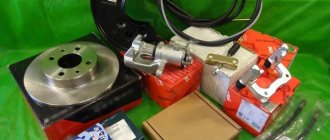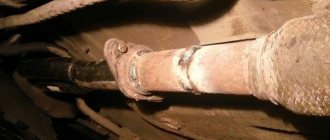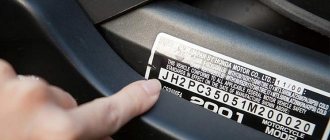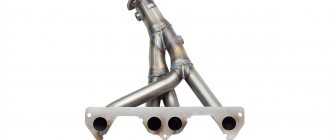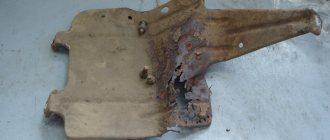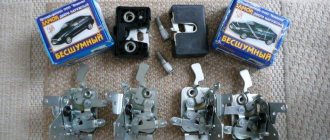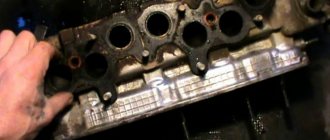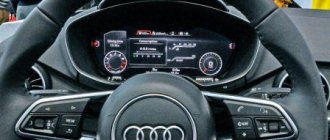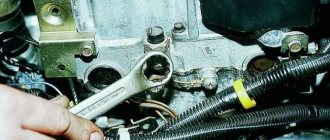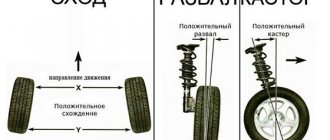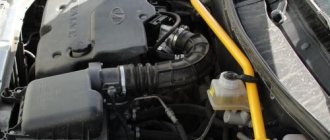Where was it found?
Fate itself gives you an encrypted signal:
- sat directly on the mirror - quick news from a near and dear person, it is possible to receive a letter, SMS, phone call:
- on things left in the cabin - you risk getting into an accident, or even parting with your favorite car.
The spider spun a web in the car
Our ancestors also considered the spider net to be a home talisman. Being the helpers of a good brownie, spiders used it to catch evil spirits who promised trouble and failure in business, and scared away evil spirits and unkind envious people who perpetrated all sorts of intrigues, causing the evil eye and damage. All this is automatically transferred to the car, because in a sense it also serves as our home.
Did you see a spider inside the cabin, and besides, it had already managed to weave a web? Don't rush to kick him out of there. Fate itself sent you this amulet. With such a “passenger”, any troubles will bypass your car. Be it technical malfunctions, traffic accidents, illegal penalties.
Many car owners are sure that a cobweb will become a reliable trap, promising happiness on a long journey. Do not tear it down and your car will be fully protected.
See a spider on the driver's mirror of a car
Have you noticed a small alien on one of the side mirrors or for your rear view? No need to casually brush it away.
Since the spider has chosen this place, expect good news. Guests will soon come to you, and maybe news will arrive from distant relatives or close friends.
Spider lives in the car
Did you see that a permanent resident appeared in the car? This is a joyful event. Reliable protection of this property is guaranteed. It will protect your pet from unpleasant incidents, eliminate conflicts, prevent financial losses due to fines, and become a good patron for all members of your family.
But there is some danger that the omen will turn back on you.
Spider in the trunk
The reason may be trivial - apparently, you have not used this utility compartment for a long time. If this is not the case and the luggage compartment is constantly in use, expect a quick improvement in your material wealth.
What to do with a spider in the car?
Superstitions when encountering spiders are usually associated with fear and disgust at the subconscious level. These secretive creatures always “emerge” from somewhere unexpectedly, therefore they have always been considered harbingers of sudden news and life changes.
Remember: negative omens are signs that fate gives about a possible event. It is not difficult to neutralize them by analyzing your immediate plans and thinking through your behavior.
An uninvited guest will not bring you anything bad. Just don't destroy it intentionally. The Universe will certainly make you pay for this act, and you will no longer have to expect anything good that the sign originally promised.
If the superstition about a spider in a car speaks more of harm than benefit, carefully release it onto the grass and politely ask it to take away everything bad with it. For example, you saw a black spider in the salon - a quarrel with your family is possible
A piece of paper will help, on which you need to sit him and then release him in nature
For example, if you saw a black spider in the salon, a quarrel with your family is possible. A piece of paper will help, on which you need to sit him and then release him in nature.
Spiders do not accumulate negative energy. Therefore, regardless of the meeting place, they are just harbingers of something unexpected. Don't think about the bad, and then the future will definitely turn out in your favor.
Internal structure
Digestive system
The spider's digestive system consists of the mouth, pharynx, esophagus, stomach, and intestines (front, middle and back). In the midgut, long blind processes increase its volume and absorption surface.
Undigested residues are expelled through the anus. The spider cannot eat solid food. Having caught prey (some insect) with the help of a web, he kills it with poison and lets digestive juices into his body. Under their influence, the contents of the captured insect liquefy, and the spider sucks it up. All that remains of the victim is an empty chitinous shell. This method of digestion is called extraintestinal.
Circulatory system
The spider's circulatory system is not closed. The heart looks like a long tube located on the dorsal side of the abdomen.
Blood vessels extend from the heart.
In a spider, the body cavity is of a mixed nature - during development it arises from the connection of the primary and secondary body cavities. Hemolymph circulates in the body.
Respiratory system
The spider's respiratory organs are the lungs and trachea. The lungs, or pulmonary sacs, are located below, in the front of the abdomen. These lungs developed from the gills of the distant ancestors of spiders that lived in water.
The cross spider has two pairs of non-branching tracheas - long tubes that deliver oxygen to organs and tissues. They are located in the back of the abdomen.
The spider's nervous system consists of the cephalothoracic nerve ganglion and numerous nerves extending from it.
Excretory system
The excretory system is represented by two long tubes - Malpighian vessels. One end of the Malpighian vessels ends blindly in the body of the spider, the other opens into the hind intestine. Harmful waste products come out through the walls of the Malpighian vessels, which are then excreted. Water is absorbed in the intestines. In this way, spiders conserve water so they can live in dry places.
Replacement on a 16-valve engine
In the case of a 16-valve power unit, the catalyst is included in the design with the output manifold. Therefore, look for it behind the cylinder block directly in the engine compartment.
The nuance of dismantling the 16-valve engine is the presence of two lambdas.
- The first is located directly on the catalyst. It serves to adjust the fuel mixture;
- The second is located on the flange after the device. It is called ecological. If this lambda is not in place, the sensor will immediately generate an error, the injection will stop working properly, thrust will increase and fuel consumption will increase.
There are two ways to solve this issue:
- If you bought a spider for one regulator, the electronic control unit can be upgraded to Euro 2 from the current Euro 3. But such a spider has a serious drawback - the only thread for the lambda is on the flange. To mount the injection lambda there, you will have to assemble an extension cord from a wire and two connectors, called mother-father.
- If it is a spider with two regulators, the injection lambda is mounted in a standard socket. The thread for the second sensor is plugged or a dummy for the electronic control unit is installed in its place. In the second situation, there is no need to reflash the ECU.
Spider Efficiency
There are a lot of companies on the Internet that say almost the same thing, put a spider on your VAZ and the power will immediately increase by 10% - WOW! That is, it was 100 hp. and then it’s 110 right away, and I’ll tell you this is noticeable!
BUT IS THIS REALLY SO? Let's understand it logically:
- Installation requires removal of the catalyst. And it has already been proven that removing this filter adds 4 to 5% power
- You need to flash it for EURO 2 - 3. Otherwise, there is no filter element! But with firmware you can catch up your car to 7 - 10% power
- Other resonators are installed. Sports as they are called! They have less resistance by another + 2-3%
- Sometimes this entire system is made from a larger pipe with a diameter of 51 mm.
SO what does the spider itself do and is it really +10%? Most likely no! YES, it gives a small increase, about 2-3% on its own (but you won’t be able to feel them, because this is at the error level). YES, and this performance OFTEN happens only in a limited range of work, for example 5000 - 6000 rpm (not always, but OFTEN). YOU need to understand that if you are planning to install it, then you need to do it in conjunction with other operations, otherwise the effect will be almost undetectable.
Now we are watching the video version.
Similar news
- Removing the catalyst. Pros and cons, consumption, firmware - revealed...
- Water in the muffler. Reasons, how to get rid of it and whether it can be drilled
- Catalyst service life. When should it be changed?
Lada 2114 Malyutkin › Logbook › Installation of spider 4-1 and CHIP Tuning
Greetings! As you know (who read me earlier), I planned to install a spider and get chipped, and finally I got around to it. First, let's stock up, I bought it at BBC:
To begin with, I studied this issue for a very long time, I learned a lot about the math part, firstly there are spiders and there are inserts, I have an insert in the photo, it differs in that the spider is longer and you will have to cut the resonator (if it’s stock) and the insert is placed on the drain without any questions , inserts also come in both 4-2-1 and 4-1, alas, I couldn’t find 4-2-1 in the city, I had to take one, there are also so-called Subaru sound, but they are not recommended, since the sound is far from Subaru and over time it gets boring, plus there’s less sense and the risk of burning out is higher, it’s better to take regular ones. So, having bought everything, you need to decide to do it yourself or on a hundred, there is nothing super complicated, but I preferred to turn to a hundred (and did not regret it, read on). I arrived, started work, removed the standard catalytic collector:
We started putting the spider and HO PA NA, we caught the unexpected:
The insert is 1-2 cm longer than necessary, as a result it rested on the drive, the mechanics themselves were surprised, they say that with the bibi it usually stands up as it should, but here things are like that, I don’t know what to do. Cutting and cooking is not an option, changing to a new one is also not an option, it’s not a fact that it will fit as it should, we went the old-fashioned way and knocked out the stock catalytic converter! Oh, it’s a pity I didn’t take a photo of how much crap was out there, it’s not surprising that the car doesn’t want to go, but in the end we get a dummy using the same 4-1 system, for nothing! Then they put it back (the new gasket on the manifold was also not useful, since the stock one was normal and to replace it, the manifold itself would have to be removed), so the purchased spider and the gasket were thrown into the trunk. They returned the catalytic collector, in the end they only installed a new gasket on the resonator from the purchases, everything else was the same as before, it began to work a little louder at idle, at high speeds the roar began to be more serious than with the catalytic converter, among the minuses - the smell of CO appeared in the cabin, but it only in some places, we’ll see how it goes, but I ended up returning the spider and the gasket, fortunately the receipt remained, although the bibs didn’t argue and returned the money without any problems. They asked for 1,500 for the work, but considering the hemorrhoids, they agreed on 2 rubles. Next is the firmware, everything is quick and painless, in my case the price was 2500, adakt firmware, they even gave a certificate (a kind of guarantee for the quality of the software) you can get through the adakt website by wine and see yourself in the database) As a result, we get: plus 10 horses, better dynamics and acceleration, increased maximum speed, reduced consumption per liter, great response to the gas pedal, even for “e-gas” in my case) I’m happy with the result and in the end I’m in the black for the money (after the return). So I can even advise this - you don’t buy anything, knock out the catalyst from the stock catalytic converter and get the same 4-1, which will go back without hemorrhoids, and then upgrade to something more dynamic with Euro 2, and you get a storm of emotions, and forget about error 0422, and calmly pour 92 gasoline. Here is the result of such a small tuning:
Spider Efficiency
There are a lot of companies on the Internet that say almost the same thing, put a spider on your VAZ and the power will immediately increase by 10% - WOW! That is, it was 100 hp. and then it’s 110 right away, and I’ll tell you this is noticeable!
BUT IS THIS REALLY SO? Let's understand it logically:
- Installation requires removal of the catalyst. And it has already been proven that removing this filter adds 4 to 5% power
- You need to flash it for EURO 2 - 3. Otherwise, there is no filter element! But with firmware you can catch up your car to 7 - 10% power
- Other resonators are installed. Sports as they are called! They have less resistance by another + 2-3%
- Sometimes this entire system is made from a larger pipe with a diameter of 51 mm.
SO what does the spider itself do and is it really +10%? Most likely no! YES, it gives a small increase, about 2-3% on its own (but you won’t be able to feel them, because this is at the error level). YES, and this performance OFTEN happens only in a limited range of work, for example 5000 - 6000 rpm (not always, but OFTEN). YOU need to understand that if you are planning to install it, then you need to do it in conjunction with other operations, otherwise the effect will be almost undetectable.
Now we are watching the video version.
What is a spider in a car?
Yes indeed - what is it?
Actually, everything is also simple here - this is the exhaust tract (manifold) which is attached to the engine block and removes exhaust gases .
By the way, our grandfathers and fathers called it “pants” (because they are somewhat similar to them). Tuners now call it a “spider” (it looks like this insect because of the plexus of pipes), especially not the standard one, but the one that has been modified according to certain formulas - dimensions - calculations (for example, 4-2-1, 4-1, etc. ., more on that a little later).
There are a lot of names, but the essence is the same. I read somewhere that this name was made to attract the attention of young people, marketing and all things, the more aggressive you call it + 10 horsepower!
Standard "glushak" - what's bad?
Actually, we’re starting to get to the most interesting part, what’s wrong with the standard system? Why does it urgently need to be replaced (I think all tuners do this)?
To begin with, what is formula 4-1 - these are four pipes (from each cylinder) that are connected at one point (pipe) and then the whole thing goes into the main path through the catalyst, resonators, etc.
NOW WHY IS SHE NOT DEVELOPED? As a rule, to please engineers, environmentalists and others, the manufacturer makes short pipes from the engine cylinders, which are immediately connected into one. Why is this bad? YES because the distance to neighboring pipes is very short. During exhaust, a certain wave is formed, which should remove gases into the main exhaust - BUT this wave also enters adjacent pipes and cylinders, thereby inhibiting the removal of gases. The situation is aggravated by the presence of a catalyst (because it is a filter and creates additional resistance), the presence of advanced resonators (sound is damped well, but gas removal is worse) and the diameter of the pipe (often made thin, within reason of course).
To put it in simple words, the engine seems to be strangling itself, that is, this is the UNDEVELOPMENT of the gas exhaust system. The engine must “breathe” (discharge waste freely), thereby increasing the power.
First signs of trouble
- The dynamics of the car have deteriorated significantly.
- The engine is difficult to start.
- There is a sulfur smell inside the car.
- At idle, the engine is unstable.
If you feel that the car has become worse, you should first check the catalyst. But, unfortunately, this is not easy to do at home, since you will need special equipment for diagnostics. Still, there are a couple of ways to check.
Checking with a pressure gauge
Method one. A pressure gauge should be screwed into the place where the lambda probe is installed. Then start the engine and see what pressure is in the exhaust system. If it exceeds 0.5 atmospheres, this is the first sign that the catalyst is faulty.
Pyrometer
Method two. In this case, you need to use a remote pyrometer and check the temperature before and after the catalyst. If the device is faulty, the temperature before and after the catalyst will be the same. This means that the internal honeycombs are destroyed and the flame suppression function is impaired. In this case, the catalyst must be replaced with a VAZ 2114. If the device is working properly, then the temperature before it will be an order of magnitude higher than after it. Depending on what power unit is installed on the car, eight or sixteen valves, replacing the catalyst has its own nuances.
Learn more about verification methods in this video:
What to expect if you meet a spider in the car
Meeting a spider in a car most often marks positive events, but future minor troubles are also possible, it depends on the circumstances and even the time of day:
- morning - most likely the day will not go well, don’t plan anything significant;
- afternoon - a quick chance for a romantic meeting;
- evening - any opportunity for unexpected joy, profit (for example, a gift or return of a long-forgotten debt) or the fulfillment of a dream;
- night - an improvement in the financial situation, but at the same time troubles.
Pay attention to the spider's behavior:
- creeps towards you - to profit, from you - to waste;
- fell from the ceiling in the cabin - to sudden events and news. If a spider falls on your face, expect good news on the personal front; if a spider falls on your legs, it means a quick trip; and if a spider lands on your hair, fate is preparing a sudden and major success;
- found a spider on your clothes - get ready for financial income.
You can try to decipher the signs of fate depending on where you found the spider:
- on the mirror - urgent news, someone near and dear will make themselves known, probably write or call;
- on any item in the car - there is a risk of losing it or damaging it.
The most pleasant events associated with a spider in a car are as follows:
- white spider - new bright love, wedding, birth of a baby;
- living in the car - if you notice a spider that has woven a web in the car, do not rush to get rid of it, this is a talisman sent by fate. Such a passenger will save you from any troubles associated with the car: sudden breakdowns, accidents and undeserved fines. It is believed that the web is a trap for happiness that will accompany you on the road.
It is important that several spiders, even small ones, found in the interior of a car mean that the omen will play out more clearly in your life
Open the interpreter
The sign “spider in the house” has many interpretations. So the ancestors were sure that seeing small arthropods would bring prosperity and good luck. The only negative point in all the predictions is that the representative of the spider world lowers
It doesn’t matter here: where, when they saw the creeping creature. It’s much worse if there are no them in the house at all.
There is so much negativity in the room that spiders cannot remove them, which makes it impossible to have a comfortable stay. This means they leave their home. If you notice an insect in a corner, on a wall, on the floor, do not be alarmed, but take a closer look at its movements and appearance. This is the only way to make a prediction for yourself and your loved ones.
Common signs about spiders
Small legs, big body - the sign “a spider in the house” indicates material wealth. You can safely begin the renovation. Getting ready for vacation. Provided that the creature stands still or crawls up. An insect with long legs and a big small body - there will be money in the house, but don’t expect enough money to buy a car, European-quality renovation, or a trip to the sea. There will be money in the family, but not in excess.
There are a lot of cobwebs on the walls and in the corners: the sign of a spider in a home serves as an indicator of urgent cleaning of the house. To do this, removing the spider web is not enough. They wash the walls, furniture, windows, dishes - everything in the room with the addition of holy water to the general liquid. After cleaning, cross the corners and walk clockwise around the apartment. During cleaning, only the wickerwork is removed, but the sign of “killing the spider” is valid - loss of wealth, the keeper of the hearth.
The color of the insect is also important. The lighter the better. But you shouldn’t be afraid of dark, black people either. The sign “spider in the corner” indicates high-quality protection of the family from negativity, damage, and the evil eye. It’s also an excellent barometer: hiding means it’s going to rain, working actively means the sun is guaranteed in the sky.
On the floor and bathroom
Seeing a spider is a great omen. Only on the condition that the insect did not settle in the bathroom. The interpretation changes are cardinal:
- behavior needs to be rethought;
- change life positions;
- stagnation in business;
- problems in personal life;
- money flows into the unknown.
But unexpectedly seeing a spider in the bathroom means a profit that was not expected. If at this moment you are afraid, the sign “spider at home” promises unpleasant news, bad news. If you notice a guest on the floor, expect changes. But carefully observe for 2-5 seconds where the visitor goes. Moving away means loss, getting closer means profit.
The sign of a “spider on a web” anywhere in a living space makes it possible to make a wish. We saw it, we made a wish, we carefully monitor the answer: up - it will come true, down - the answer is negative. Also, noticing a flycatcher weaving a web is a harbinger of prosperity. The location doesn't matter. We saw it. They asked us to weave strong nets for good luck. Now, fearlessly take on risky ventures related to money.
On the wall
Signs associated with a spider seen on the ceiling or wall have a different interpretation. The higher it sits, the more profitable it is for the owner. A spider on the ceiling brings omen, especially if it has fallen, only good news, a large inheritance, material wealth. A person was working, doing household chores, and the “neighbor” drops in front of his face? Then expect pleasant surprises, new profitable acquaintances, news with positive aspects. A sharp change in direction means that everything good will be overshadowed by trouble. Perhaps someone will jinx it, steal, or deceive.
Meeting time
Seeing a spider in the evening is definitely a wonderful, and most importantly, profitable omen. Expect pleasant, positive changes in your personal life and career growth. Problems go away and things return to normal. The sign “a spider is crawling down” in the evening is a warning. Thoughtless spending of money is a financial ruin. You can bring problems of the material plane.
The sign “spider at night” means quick financial stability. But you can’t tell anyone about success. Judge your profit and career by size. The larger the body, the more significant the support of fortune.
In the morning we noticed a spider crawling - a positively charged sign. Portends success and good luck in all areas of life. But keep track, do not forget about the direction chosen by the insect.
If you get caught in a web, you should ward off trouble and trouble. Say “Cheer me.” Such a ritual helps to get rid of negativity and troubles if done right away. Applies to any sign of a “spider in the house”
It is especially important to remember: killing an insect on purpose is prohibited. You will attract troubles and misfortunes
Some features
There are several nuances that should be taken into account when modifying the exhaust system of a VAZ-2114. The installed tuning manifold is wider in size, so it will touch the rubber pipe leading to the stove. To prevent this from leading to coolant leakage in the future, this pipe should be replaced with a new, longer one, and taken away from the manifold.
The lambda probe will also have to be replaced, since the hole for its mounting in the tuning manifold is lower than in the standard one, which is why this sensor with extended wiring is needed.
Also, the “Spider” is more voluminous at the bottom, so installing underbody protection is no longer possible.
The final stage of all this work is reflashing the electronic control unit, which will allow the new exhaust system to be “perceived” as standard. Also, flashing will allow you to “unleash” the full potential of the power plant after processing. It is better to perform flashing from knowledgeable specialists at a service station.
This is all the work related to the processing of the exhaust system of the VAZ-2114 car.
Internal features of the structure
The internal structure of the spider resembles the structure of a cancer, but still has its differences. Some systems, such as the circulatory and digestive systems, extend along the entire body. But most of the internal organs are concentrated in the abdominal region.
Digestive system
The spider cannot digest solid food. Its digestion begins from the outside, when with the help of chelicerae it injects into the victim not only poison, but also enzymes that act as digestive juice. After a while, only the liquid contents remain in the chitinous shell of the caught insect, which the hunter drinks. The semi-digested liquid then passes through the digestive organs. These include:
- mouth;
- pharynx;
- esophagus;
- sucking stomach;
- intestines (fore, middle and hind intestines) with blind outgrowths, which allows the spider to consume a lot of food;
- the liver, which is essentially glandular protrusions of the midgut and serves for intracellular digestion of food.
The digestion process takes place in three stages: first, external digestion, then intestinal, and after that intracellular. The process of fluid absorption takes place in the intestines. This helps save water in the body and helps the spider survive in dry areas.
Respiratory system
The respiratory system is represented by two types of paired organs, namely:
- two pulmonary sacs;
- tracheas.
The lungs (pulmonary sacs) are located in the front of the abdominal cavity. Inside them there are many folds-plates, between which there is air. A blood-like fluid, hemolymph, also circulates there. Enriched with oxygen, it distributes it throughout the body.
Find out why the six-eyed sand spider is dangerous and what to do if it bites you.
The tracheae are located in the back of the abdomen and look like two bundles of long, unbranched tubes. Their job is to deliver oxygen directly to the organs.
Both the lungs and trachea have breathing holes at the bottom of the abdominal cavity.
Circulatory system
The organs that make up the circulatory system include:
- tube-shaped heart with 3 pairs of holes (ostia);
- vessels, the largest of which are the anterior and posterior aortas.
In an open system, hemolymph moves along the following route:
- Through the ostia, fluid enters the heart.
- From there it moves through the aortas.
- From the anterior aorta, which is located in the cephalothorax, hemolymph flows through small arteries.
- It flows from the vessels into the body cavity and washes all internal organs, delivering them oxygen and other nutrients.
Did you know? Spider blood, hemolymph, is not red, but blue, since it contains the pigment hemocyanin, which contains copper.
Excretory system
The organs of the excretory system are:
- paired Malpighian vessels;
- two coxal glands.
Malpighian vessels are long tubular outgrowths of the intestine. With the blind end they go into the abdominal cavity, and with the open end into the hindgut. Through their walls, metabolic products are absorbed from the hemolymph, which are then excreted in the form of guanine crystals through the anus along with the remains of undigested food.
The coxal glands are like sacs that are found inside the cephalothorax. Canals diverge from them, the end of which are excretory ducts located at the base of each walking leg. That is why there are as many exit channels as the spider has legs.
Operating principle of the exhaust manifold
The movement of gases through the exhaust channels is a wave process, which they experimentally try to reconcile with the wave processes that arise when the fuel mixture moves in the suction tract. The opening of the exhaust valve causes gas under pressure to flow from the combustion chamber into the exhaust manifold. In this case, the pressure difference in these two cavities leads to the formation of a wave, which is reflected from nearby obstacles (for example, a catalyst), is directed back to the cylinder and reaches it at the time of the next exhaust stroke. Such a sharp removal of combustion products leads to the formation of a vacuum in the cylinder, which improves the cleaning of the cylinder itself and more quickly fills it with fresh combustible mixture. The wave propagates at the speed of exit from the cylinder, so the resulting resonance is formed in the pipe in a fairly wide range of revolutions. Consequently, an increase in engine speed leads to an acceleration of the exit of gases from the cylinder and an acceleration of the movement of the wave, which just manages to return to the beginning of the next, shorter cycle.
How to make a replacement
The entire replacement of the VAZ 2114 spider takes place in several stages:
- Place the car on an overpass or pit, put the handbrake on and secure the wheels with stops (shoes).
- If the car has been running recently, let it cool down.
- Remove the crankcase protection.
- Unscrew the bolts securing the exhaust manifold pants to the catalyst inlet (to make unscrewing easier, they should be treated with WD-40 lubricant before starting work).
- If the replacement is partial, then leave the catalyst and muffler in place; if it is complete, then remove it.
- Unscrew the nuts securing the manifold to the cylinder head.
- Dismantle the “original” manifold and the gasket located under it.
- Install the spider instead of the standard manifold (if the spider matches the model, then it will definitely fit into its place). Before installation, you should place a new gasket under it.
- If the old fasteners are severely corroded, then new ones should be installed instead, preferably coated with copper or brass.
- If a partial replacement is performed, then you need to check the alignment of the spider pipe with the catalyst inlet. As a rule, the exhaust pipe of the spider is longer, so you will have to cut off and dismantle not only the catalyst, but also part of the exhaust pipe, instead of which a resonator should be welded.
- Connect the spider's output pipe to the resonator.
- If a complete replacement occurs, then the same operations are performed as in the previous paragraphs, but instead of the entire “original” exhaust system, a direct-flow exhaust system is installed.
Implementation
So we want to crawl the Internet and store it for later processing.
Of course, for demonstration purposes, it will not be possible to bypass and save the entire Internet - it would be VERY expensive, but we will develop the code with an eye to the fact that it could potentially be scaled to the size of the entire Internet.
This means that we must work on a large number of servers at the same time and save the result to some kind of storage from which it can be easily processed. I chose Amazon Web Services as the basis for my solution, since there you can easily raise a certain number of machines, process the result and save it to Amazon S3 distributed storage. Similar solutions are available, for example, from Microsoft, and Yandex.
Architecture of the developed solution
The central element in my data collection scheme is the queue server, which stores a queue of URLs to be downloaded and processed, as well as a set of URLs that our processors have already “seen”. In my implementation, they are based on the simplest Queue and set data structures of the python language.
In a real production system, most likely, instead of them it would be worth using some existing solution for queues (for example, kafka) and for distributed storage of sets (for example, solutions of the in-memory key-value class of databases like aerospike would be suitable). This would allow us to achieve full horizontal scalability, but in general the load on the queue server is not very large, so there is no point in such scaling in my small demo project.
Working servers periodically pick up a new group of URLs for downloading (we pick up a lot at once so as not to create unnecessary load on the queue), download the web page, save it on s3 and add new found URLs to the download queue.
In order to reduce the burden of adding URLs, additions also occur in groups (I add all new URLs found on the web page at once). I also periodically synchronize many “seen” URLs with production servers in order to pre-filter already added pages on the side of the production node.
I save downloaded web pages on distributed cloud storage (S3) - this will be convenient later for distributed processing.
The queue periodically sends statistics on the number of added and processed requests to the statistics server. We send statistics in total and separately for each working node - this is necessary to make it clear that downloading is happening as normal. It is impossible to read the logs of each individual working machine, so we will monitor the behavior on graphs. I chose graphite as my download monitoring solution.
Review of the exhaust system of Lada Priora
The exhaust gas exhaust system on the Lada Priora performs the following functions:
- exhaust gas removal;
- noise reduction when the engine is running;
- neutralization of toxic hazardous substances in exhaust gases.
The basis of the Priora exhaust system includes:
- 1. Exhaust manifold with converter;
- 2. Resonator;
- 3. Main muffler;
- 4. Auxiliary muffler;
- 5. Connecting pipes.
Exhaust on Priora
The manifold is used to remove exhaust gases from the cylinders into the exhaust pipe. The tightness of the connections is ensured by sealing with a metal gasket in two layers between the block head and the exhaust manifold. The attachment of the exhaust manifold to the cylinder head on one side goes into connection with the converter on the other. The collector and converter connected into one unit make it possible to reduce the warm-up time to the operating temperature of the latter, which significantly increases the efficiency of the converter.
Installation of oxygen concentration sensors at the inlet and outlet of the converter ensures constant monitoring of the quality of exhaust gases. The connection between the intake pipe and the manifold has a heat-resistant seal in the form of a metal-asbestos gasket. And the metal compensator connecting the additional muffler with the exhaust pipe serves as a vibration damper from the engine to the body and the entire exhaust system.
The exhaust gas exhaust system is connected by attaching it to the body brackets using 4 rubber rings. On the main muffler, the suspension cushion has a reinforced structure, which is due to the increased load on it.
Standard "glushak" - what's bad?
Actually, we’re starting to get to the most interesting part, what’s wrong with the standard system? Why does it urgently need to be replaced (I think all tuners do this)?
To begin with, what is formula 4-1 - these are four pipes (from each cylinder) that are connected at one point (pipe) and then the whole thing goes into the main path through the catalyst, resonators, etc.
NOW WHY IS SHE NOT DEVELOPED? As a rule, to please engineers, environmentalists and others, the manufacturer makes short pipes from the engine cylinders, which are immediately connected into one. Why is this bad? YES because the distance to neighboring pipes is very short. During exhaust, a certain wave is formed, which should remove gases into the main exhaust - BUT this wave also enters adjacent pipes and cylinders, thereby inhibiting the removal of gases. The situation is aggravated by the presence of a catalyst (because it is a filter and creates additional resistance), the presence of advanced resonators (sound is damped well, but gas removal is worse) and the diameter of the pipe (often made thin, within reason of course).
To put it in simple words, the engine seems to be strangling itself, that is, this is the UNDEVELOPMENT of the gas exhaust system. The engine must “breathe” (discharge waste freely), thereby increasing the power.
Selecting the appropriate modification
Part installed on the car
When choosing a spider for a Priora, two options are most often considered - 4-1 or modification 4-2-1. It all depends on what final result we want to get. The 4-1 manifold produces an optimal increase in power in a fairly narrow rpm range. It has four pipes from the valves connected into one without transitions. Collectors are available with both short and long pipes. Modification 4-1 is suitable for engines with high afterburner, speed range from 6 to 10 thousand per minute. Typically, these “spiders” are installed on engines with camshafts with a phase of more than 285 degrees.
Spider 4-2-1 is a part in which four pipes from the cylinders are connected first in pairs, and then into one common pipe. It gives a less significant increase, but over a wider rpm range. These parts are installed on medium-boosted engines. It is believed that short versions of the 4-2-1 model are effective at revolutions above 4500 per minute, and long ones at average speeds from two and a half to four thousand per minute.
The 2-2 “spider” configuration, when four pipes turn into two in pairs, each of which has a separate outlet, (you get two outputs) is practically not found in mass production. However, amateur welders perform modifications for themselves, as shown in the photo. Such work was carried out by autogen and camping, for which pipe blanks were cut and adjusted using angles. Some believe that this 2-2 “spider” configuration does not provide the ability to connect a lambda, so its use is not always justified.
There is no single scheme for selecting a 2-1 spider or another for a Priora car, since the choice of modification is made mainly during testing on a bench. But there is a formula for the length of the primary pipe (the distance from the valve to the end of the primary pipe) which is the following:
L = A x C x DxD / 1400 (constant) x BxB, where
| Variable | Meaning |
| A | this is the exhaust phase (measured in degrees of crankshaft rotation) |
| D | cylinder diameter in inches |
| WITH | piston stroke in inches |
| IN | outlet diameter, also in inches |
The resulting length must be multiplied by integers. The total length of the pipes from the connection to the valve on the Priora is approximately (!) determined by the formula (regardless of the 2-1/4-1 modification):
M = 2159 x (K+180)/T – P, where
K – size of the exhaust channel opening in degrees before BDC, along the crankshaft;
T – required engine speed for which the car is tuned;
P is the length of the outlet channel.
After the car owner has decided on the required “spider” model, he needs to purchase a muffler, a resonator (direct-flow, sports), a graphite ring and an oxygen sensor adjusted to the length to carry out the work. Models 4-2-1, offered in stores for the Priora car, have a nut for the oxygen sensor, so installing it will be quite easy. If the spider does not have a built-in sensor, then after installing it you will need to replace the firmware on the ECU.
When purchasing, you need to look at what engine capacity this or that “spider” is designed for, as well as the diameter of the pipes. The increased diameter of the secondary pipes, for example, contributes to improved cleaning of the cylinders from exhaust gases. The output flange of spider manifolds offered on the market is usually 51 or 63 mm.
What is the problem with release anyway?
There are only two problems:
- It's noise. That's why the exhaust system is often called a muffler to dampen loud sounds.
- This is ecology. Not all gases burn in the combustion chamber, and to put it in “simple language” they need to be “burned or decomposed” into more or less safe components, this is done by the catalyst.
If there were no muffler, the engine power would be approximately 10% more by default (depending on the valve and camshaft settings). BUT it would be impossible to drive such a car, firstly, you yourself would become deaf from the crackling sound that escapes from the engine (and you would be fined for disturbing the peace of citizens, this is now punishable by law), and secondly, the environmental component would be worse zero, because there is no catalyst (and we already have a polluted world that requires global cleaning) - it is not possible to pass MOT with such an indicator, and even now traffic police officers can easily check the exhaust.
In general, the gas muffling system CANNOT be removed, but it can be improved, which is exactly what tuners do.
Types of collectors
The first type is a standard exhaust manifold. It is installed on most modern cars for more environmentally friendly operation and combines the manifold and catalyst. Its main job is to burn the remaining unburnt gasoline.
catalyst
Pros and cons of the spider 4-1
The second type of exhaust manifold is the 4-1 spider. The structure of such manifolds is similar to a factory catalyst, but the 4-1 spider has four pipes that come out of the engine with a larger diameter and the exhaust gas retention is less pronounced. As a rule, this type of collectors is cheaper.
spider 4 1
Its structure is simpler and it is a simpler form. The design of such a collector involves the connection of four pipes into one thicker one and then a transition to the resonator. They are most often used on sports, high-revving engines, since the operating range of the 4-1 manifold is over six thousand revolutions.
Pros and cons of the 4-2-1 spider
And finally, the latest manifold design used in civilian, atmospheric tuning is the 4-2-1 spider. The purpose of such a spider is to lengthen the collector itself as much as possible and make sure that the exhaust gases leaving the engine touch and interfere with each other as little as possible.
The structure of such a manifold is made in such a way that the burnt gas-air mixture coming out of the first cylinder through pipes is connected to the fourth, and the second is connected to the third, and then these two pipes are connected into one.
Spider and its varieties
The main difference between the spider and the original VAZ exhaust manifold is:
- absence of sharp corners in the path of gases;
- multi-level direct-flow system (4-2-1 type);
- lack of internal components (it is they, first of all, that “bring” the engine’s performance to the Euro-3 standard and at the same time reduce its power).
Spider 4-2-1 and factory manifold VAZ 2114
In terms of its structure, the spider 4 2 1 2114 is a complex system of tubes connected to each other. As you might guess, there are 4 pipes coming from the engine itself, which at some distance combine into 2, and then into 1 exhaust pipe. This combination of tubes during engine operation creates air pressure differences, which contribute to maximum cleaning and purging of the cylinders and, as a result, increasing the overall engine power.
Spider 4 2 1 for VAZ 2114
It should be noted that after installing the spider, the “environmental friendliness” of the car will decrease, and there will be no compliance with the Euro-3 standard. In all other respects, replacing this part will only benefit the car.
In addition to spiders of type 4 2 1, the action of which has already been described, you can also find spiders of type 4 1 in stores. The difference between them is that in the latter version, 4 tubes extending from the engine immediately turn into 1, bypassing the intermediate stage of 2 tubes.
Such spiders are intended exclusively for boosted engines and provide an increase in power compared to a standard manifold only at speeds of 6500 rpm or more. That is why the spider 4 2 1 on the VAZ 2114 is a better option than the spider type 4 1.
Spider 4 1 for VAZ 2114
It should be noted that the entire modernization process will not be limited to just installing the spider. In addition to this, you will also need to install a direct-flow exhaust system, a resonator and remove the catalyst.
Thus, if you decide to replace the manifold, you will, in fact, have to replace the entire exhaust system. True, you can limit yourself to just replacing the catalyst with a resonator, but in this case the overall increase in power will be noticeably less (about 5 hp instead of 12-15 hp with a complete replacement of the exhaust system).
What is the problem with release anyway?
There are only two problems:
- It's noise. That's why the exhaust system is often called a muffler to dampen loud sounds.
- This is ecology. Not all gases burn in the combustion chamber, and to put it in “simple language” they need to be “burned or decomposed” into more or less safe components, this is done by the catalyst.
If there were no muffler, the engine power would be approximately 10% more by default (depending on the valve and camshaft settings). BUT it would be impossible to drive such a car, firstly, you yourself would become deaf from the crackling sound that escapes from the engine (and you would be fined for disturbing the peace of citizens, this is now punishable by law), and secondly, the environmental component would be worse zero, because there is no catalyst (and we already have a polluted world that requires global cleaning) - it is not possible to pass MOT with such an indicator, and even now traffic police officers can easily check the exhaust.
In general, the gas muffling system CANNOT be removed, but it can be improved, which is exactly what tuners do.
Spider 4-1
This type of spider is not very common in road cars, as it only begins to affect engine performance after 6000 rpm. How often in the city do you rev the engine to at least 5000? But never. And if you do not plan to do very serious boosting of the engine, then there is no need to install this spider for yourself. Yes, and there are problems, in the “classic” for example, you have to saw through the body near the checkpoint.
Thanks for subscribing!
Additional details
There are mufflers on sale with or without pre-installed decorative nozzles at the end of the pipe. Nozzles differ in shape and installation specifics. Some will require boring out some space on the bumper. Check with the manufacturer for information about the selected model.
Straight-through muffler Stinger
Nozzles
The attachments add aesthetics to the appearance of the VAZ 2114. There are 3 options for attachments on sale:
- oval
- circle
- DTM (rounded rectangle shape).
Installation is carried out using bolts (included).
Connecting clamp
Necessary for connecting the muffler to the resonator. This is a metal ring with a rubber seal, tightened with bolts.
Rubber rings
Attach the muffler to the body. To replace you will need 3 rubber bands. When installing a new part, it is recommended to immediately change the rubber bands. Their service life is usually 2-3 years, and their low cost allows them to make repairs for future use.
Spider 4 2 1 VAZ 2110 8 valves
This product was chosen by 20 customers
For an 8-valve engine with a nut for 1-2 oxygen sensors.
After installing the spider, you will need to change the standard program and an oxygen sensor extension. The spider is installed complete with a Stinger direct-flow resonator without welding; in the case of a standard resonator, welding will be required.
Diameters:
- primary pipes - 38 mm;
- secondary - 43 mm;
- output - 51 mm.
Material: steel 08 ps cold rolled.
Power gain: 9.5 hp
When ordering in the cart, in the order explanation line, indicate for how many sensors you need a Spider for 1 or 2!
Weight, kg: 4.55 Dimensions, cm: 76 x 37 x 32 Volume, m3: 0.08998
I installed the spider, do I need firmware?
Currently, there are a large number of manufacturers of sports spiders. They all claim that by installing a 4-1 spider or 4-2-1, the power of your four-cylinder engine will increase by up to 10%. This is confirmed by video clips and measurements on a dyno, but is it really so? Manufacturers don’t tell us a little, since replacing the standard manifold with a spider will disrupt the correct operation of the engine.
power measuring stand
When a new car is produced, a standard program is installed in the engine control unit, which monitors exhaust gases and is set to a certain pressure in the exhaust manifold. When installing the spider, the pressure in the exhaust system changes and an engine error light appears on the dashboard. At the same time, the car begins to consume more gasoline and its power drops significantly. In order to avoid this, it is necessary to change the factory engine settings to the so-called euro two firmware, or even zero euro. Such firmware is more universal and can be easily installed at service stations where they do chip tuning. But absolutely identical motors simply do not exist, and in order to achieve maximum performance when installing a spider, you need to individually calibrate your engine.
Spider 4-2-1 and 4-1. Like tuning the exhaust system. What is it and why is it needed at all?
It's no secret that the internal combustion engine has a very low efficiency (gasoline is around 25%, diesel can be pumped up to 40 - 50%). There’s nothing to be done, but these motors are essentially last century (I think electric cars are just around the corner). The matter can be corrected with all sorts of modifications, for example, installing a turbine, lightening the design of the pistons, crankshaft, etc. Refinement of intake and exhaust systems. This is exactly the issue that many tuners are currently struggling with, because in the right hands you can actually remove up to 10% of the power. But how does this happen? Some people think that it is enough to install the so-called “spider” according to the formula 4-2-1 or 4-1 and that’s ALL! BUT what is this anyway? What spiders, what formulas - what it gives and how it is configured. Read on and you will understand everything...
THE CONTENT OF THE ARTICLE
Let's start with the fact that any engine has an intake and exhaust manifold . It is clear that the fuel mixture (air + gasoline) enters through the “intake”, and exhaust gases (burned in the combustion chamber) leave through the “exhaust”. So, if you make the exhaust system as unobstructed as possible, you can achieve a slight increase in power.
